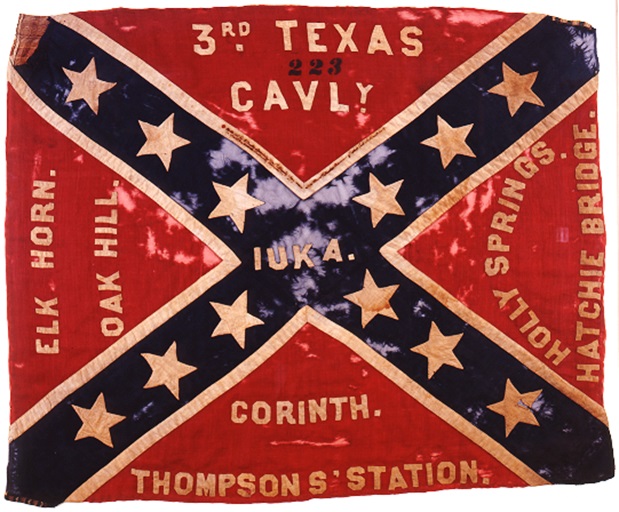One hundred and fifty years ago today, the abolition of slavery was announced in the State of Texas. The holiday in commemoration of this event is known as Juneteenth, and (according to the relevant wiki) it has been expanded to include “the emancipation of African-American slaves throughout the Confederate South.”
Today is also the day after Walker v. Texas Division, Sons of Confederate Veterans, Inc. was handed down by the Supreme Court of the United States, telling the State of Texas that they are within their legal rights to reject a Confederate flag design for automobile license plates, because such plates are primarily government speech and therefore not governed by First Amendment protections.
Today is also two days after the mass shooting at the historic Emanuel AME Church in Charleston, South Carolina, which has ignited a fresh round of debate over the purpose and meaning of the Confederate Battle Flag.
Confederate flag flying on SC Capitol grounds provokes renewed anger after Charleston shooting http://t.co/nlpD80Okjq pic.twitter.com/WiVxQpXt8e
— ABC News (@ABC) June 18, 2015
PETITION: Tell SC Gov. @nikkihaley to take down #Confederate flag: http://t.co/8jhgkQ9c3G #CharlestonShooting pic.twitter.com/7KhErxouYG
— Southern Poverty Law Center (@splcenter) June 19, 2015
The shooting at a Charleston church has reignited the debate about the confederate flag http://t.co/RGypNgMpTD pic.twitter.com/94j7qNnRhf
— The New York Times (@nytimes) June 19, 2015
Whenever debates over symbols break out, we see people talking about what those symbols mean to them and how the symbols make them feel. No one can be wrong about their own feelings, of course, but when one side says “pride not prejudice” and another says “white supremacy” it seems we need to consider narrowing the question and taking a more historical approach. Take this particular flag, by way of example:

The 3rd Texas Cavalry was composed of real people, fighting for well-specified causes, just over a century and a half ago. The causes for which they fought were officially announced on a particular day in a particular document. If you take the trouble to read that document (as every Texan should) it will become clear that no single concern was more vital to secessionist Texas than preserving systemic racial subjugation and enslavement within their borders.
Texas abandoned her separate national existence and consented to become one of the Confederated States to promote her welfare, insure domestic tranquility [sic] and secure more substantially the blessings of peace and liberty to her people. She was received into the confederacy with her own constitution, under the guarantee of the federal constitution and the compact of annexation, that she should enjoy these blessings. She was received as a commonwealth holding, maintaining and protecting the institution known as negro slavery–the servitude of the African to the white race within her limits–a relation that had existed from the first settlement of her wilderness by the white race, and which her people intended should exist in all future time. Her institutions and geographical position established the strongest ties between her and other slave-holding States of the confederacy. Those ties have been strengthened by association. But what has been the course of the government of the United States, and of the people and authorities of the non-slave-holding States, since our connection with them?
The controlling majority of the Federal Government, under various pretences and disguises, has so administered the same as to exclude the citizens of the Southern States, unless under odious and unconstitutional restrictions, from all the immense territory owned in common by all the States on the Pacific Ocean, for the avowed purpose of acquiring sufficient power in the common government to use it as a means of destroying the institutions of Texas and her sister slave-holding States.
The meaning here is straightforward and unambiguous. The 3rd Texas Cavalry was fighting for “the institution known as negro slavery” against those who would seek to destroy “the institutions of Texas and her sister slave-holding States.” No amount of historical reinterpretation is going to wave that problem away.
Lest anyone think that I’m focusing exclusively on Texas, let’s have a look at South Carolina, home of presidential hopeful Lindsey Graham.
South Carolina's Lindsey Graham defends Confederate flag: "It works here" http://t.co/l9ctJzBOZC pic.twitter.com/V4wjtF13Ul
— The Hill (@thehill) June 19, 2015
That state also issued a declaration of causes for secession and this document is essentially an extended argument that “an increasing hostility on the part of the non-slaveholding States to the institution of slavery” has caused those states to violate their Constitutional obligation to preserve the “right of property in slaves” which was “established in fifteen of the States and recognized by the Constitution.” Whatever spin Senator Graham tries to put on it, this is what South Carolinians were fighting for under that bloody banner.
Symbols are bound to resonate differently to different people, but we must not forget that Confederate flags were originally created to give meaning to a secessionist movement which was focused first and foremost on keeping African Americans enslaved.
